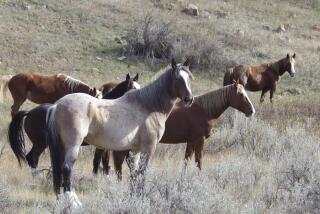Where Wild Horses Roam
- Share via
HUSTAIN NURUU RESERVE, Mongolia — About four miles off the main road, Sukhtulga scans the mountain steppes with binoculars as our Russian jeep bounces slowly along the rutted dirt path. Then, beneath a ridge nearly a mile away, he spots them: two short, stocky horses grazing in the sway of a saddleback.
It will be a hike, the guide warns, but if we move quickly and quietly, we might be able to get closer.
So we slip from the jeep and begin the long walk over rock-strewn terrain, wavering between optimism and pessimism. The reserve measures nearly 200 square miles. About 40 takhi, rare wild Przewalski’s (sha-VAL--ski) horses that are extinct in the wild, live here under an international program aimed at reestablishing them in their natural habitat.
We’ve already beaten the odds just by spotting two of them.
But as we watch, the horses wander from view over the top of the ridge.
“The Discovery Channel was out here for two weeks and never saw a horse,” Sukhtulga warns.
Fifteen minutes later we crest the ridge to find nothing but more steppes, a staggering view of grassy peaks, valleys and arroyos. Wolves live among the trees, Sukhtulga says. The takhi live out in the open.
But they aren’t there now.
Disappointed, we move up the ridge. After a few moments, the lead hiker turns back to say something, but his words are immediately forgotten. Just behind us, at the ridge’s low point, grazes a harem group--a stallion, seven mares and four spindly legged foals.
The tawny stallion--known to preserve workers as Khan--watches us as we watch him, nose up and head back, his short black mane blowing in the dry, stiff wind.
“I feel happy every time I see them,” says Sukhtulga, 27, who lives at the edge of the Hustain Nuruu Reserve with his wife and 4-year-old daughter. “I feel proud being involved with these projects. I never get tired of watching them.”
*
No one can say for sure what happened to the last of the original takhi, the wild horses that once roamed the Eurasian steppes and defined the Mongolian soul.
One account credits the last confirmed sighting to a herdsman near the arid edge of the Gobi Desert in 1968. Another account says a Mongolian scientist spotted a wild stallion a year later near a spring in the same general area.
Regardless, no one has seen a takhi in the wild since then. The key cause for the eradication is a familiar one: growing encroachment by people and livestock that pushed the takhi into inhospitable ranges.
The only known surviving takhis are the more than 1,000 kept in zoos and game farms around the world. Among those are a dozen that roam an 11-acre enclosure at the San Diego Wild Animal Park in Escondido, where they are part of a species-survival breeding program.
But the takhi could be making a comeback in their native habitat.
Under an ambitious experimental program begun five years ago, naturalists from Mongolia and the Netherlands are reintroducing farm-raised takhi to the vast Hustain Nuruu Reserve about 65 miles outside the Mongolian capital of Ulaanbaatar.
So far, 44 horses have been released into the wild, living in three harems each dominated by a single stallion, and in a fourth group of young “bachelor” stallions. By 2000, supporters say, some 100 horses could roam wild over the mountain steppes.
“It’s probably too early, but we believe it will be a success,” project director Jan Vegter says.
*
Hustain Nuruu is one of at least seven programs worldwide aimed at preserving the takhi and the only one to have released horses into the wild. The animals are monitored by rangers but left to their own devices to find food and water and to defend themselves against wolves.
At Hustain Nuruu, 12 foals have been born, two of which died at birth and three killed by wolves. Vegter said the survival rate--seven of 12--is acceptable this early in the program.
Supporters--including the Dutch government, which is underwriting some of the project--hope the Hustain Nuruu experiment will go further than simply reestablishing the takhi.
“We’re less concerned with reintroduction than with supplying the people of Mongolia with the means of developing a way of integrating land use and nature conservation,” says Michiel F. Wallis de Vries, one of the project’s first directors.
Among Mongolians, though, interest is focused on the takhi itself. Even this late in the 20th century, horses infuse the national identity. Fermented mare’s milk is part of the daily diet in the countryside, and nearly half the population of 2.5 million lead semi-nomadic lives, using horses to keep track of their herds.
Mongolian history was built on horseback. Genghis Khan’s 13th-century armies gathered their thunder from their horses, riding them to domination from the Pacific Ocean to the Mideast and Hungary. Against that backdrop, the takhi--Mongolian for “holy”--has assumed mythical proportions, in large part because it is the horse that got away--takhi are the only existing species of horse that even Mongolia’s celebrated horse trainers could not tame.
“A Mongolian without a horse,” Sukhtulga says, “is like a bird without wings.”
In prehistoric times, the horses ranged as far west as Europe--their images appear in French, Italian and Spanish cave drawings--and into China and Siberia. But by the mid-1800s, human encroachment, hunting by non-Mongolians and competition with domestic livestock for grazing areas reduced the takhi’s range to the edges of the Gobi desert in southeastern Mongolia and north-central China.
Early Western observers of the horses believed that the Gobi was the takhi’s natural domain. But naturalists now are concluding that the Gobi was simply their last terrain. And since they did not survive, then it likely was not their best habitat.
The Hustain Nuruu project in essence splits the difference, reintroducing the horses to grassy steppes where food and water are more plentiful than they are near the Gobi, but not as plentiful as farther west in Central Asia.
*
“It seems to be pretty successful,” says Lee Boyd, an associate professor of biology at Washburn University in Topeka, Kan., and co-editor of “Przewalski’s Horse: The History & Biology of an Endangered Species” (State University of New York Press, 1994).
“The reproduction rate is certainly good, and the horses seem to have acclimated very well,” she said.
Those very successes, though, could contain the seeds of eventual problems. As the number of takhi increases, they will begin wandering off the reserve, which will increase their contact with domestic horses. Interbreeding would muddy the takhi’s distinct genetic structure--it has two more chromosomes than other horses--and could threaten the species’ survival.
Vegter hopes rangers will be able to keep the wild horses segregated until they number 100 or more, at which point the effect of cross-breeding on the gene pool would be lessened.
*
The takhi-reintroduction program developed after a Dutch couple--Jan and Inge Bouman--began opening game preserves in Europe in the late ‘70s stocked with horses bought from zoos and other game farms.
Through their Foundation Reserves Przewalski’s Horse organization, the Boumans teamed up with the Mongolian Assn. for Conservation of Nature and the Environment and established the Hustain Nuruu reserve. In 1992, the first 16 horses were shipped to Mongolia from reserves in the Netherlands and Ukraine.Since then, two more shipments of 16 horses each have arrived at Hustain Nuruu. Sukhtulga joined the Hustain Nuruu Project as it was releasing the first horses. At least two more shipments of 16 horses each are planned by 2000.
“By then we think we’ll have a good genetic base and the horses can survive on their own,” Sukhtulga said. “After that, we probably won’t get any more horses. But that is what the foundation was set up for.”
More to Read
Sign up for Essential California
The most important California stories and recommendations in your inbox every morning.
You may occasionally receive promotional content from the Los Angeles Times.











